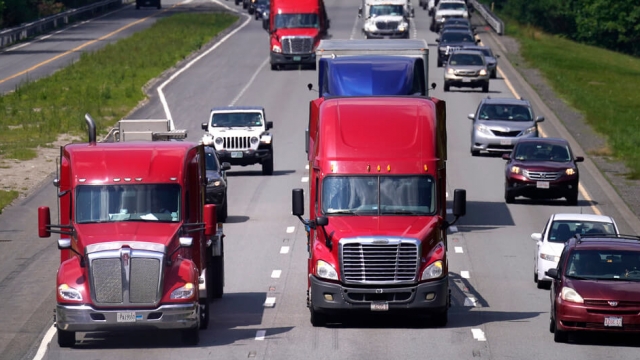After an industry boom during the pandemic, the trucking industry is facing a rapid slowdown.
As truckers struggle to keep up work, the industry battles declining freight and ocean trade and a cooling market.
The trucking industry is central to the American economy and trade.
According to the American Trucking Associations, trucks move nearly 75% of the nation's freight compared to planes or railways and generate over $940 billion in revenue.
But the industry is facing a slowdown, with tens of thousands of trucking companies shutting down operations since the fall of 2022, most of which are independent operators with just one truck.
Manufacturing orders and ocean freight have declined since 2022. Industry leaders cited a deceleration in US retail sales, high inventory levels, and inflation.
With less inventory getting moved and less demand for trucks, drivers can struggle to make a profit, dropping quickly from $20,000 a month to a little over $3,000.
Truck owners essentially bid on jobs to take, and when there are more owners than jobs available, the bids get lower and lower.
According to one trucking logistics and analytics firm, typically, drivers need at least 40 cents a mile in profit to build up cash and maintain the vehicle. That rate has plummeted from $1 a mile in 2021 to about 3 cents today.
SEE MORE: Truckers Protest Proposed Restrictions On Private Contractors
The founder and CEO of data analyst firm Freight Waves warned CNBC that things could even get worse.
"It's certainly doom and gloom; some have described it as bad as the great recession, and I've even heard statements from folks that believe it will get worse than the great recession," said Craig Fuller.
The sudden bust of the trucking industry is a dramatic shift from earlier in the pandemic, when demand for truckers had soared.
Instead of a surplus, a shortage of truckers across the country drove many independent drivers to buy their own vehicles and enter the industry.
"We normally have like 55–60 students; we've got 82 right now. A lot of the companies are experiencing shortages; they call us constantly for drivers," said Larry Scott.
In April 2022, President Joe Biden invited a group of truckers to a press conference, where he announced more than 35,000 jobs had been added since the pandemic began. Secretary of Transportation Pete Buttigieg also touted federal assistance and initiatives to increase hiring.
"Right now, the industry estimates that we're short 80,000 truck drivers, and my department estimates that 300,000 leave the career every year. So we must do more and do better to recruit more people into the job and to support them so they choose to stay in the job," said Pete Buttigieg.
This coincided with a spurt of social media posts with millions of views, spotlighting truckers making hundreds of thousands of dollars and urging others to get their own truck.
SEE MORE: Why is the trucking industry changing?
"I started a trucking company from scratch, and in three months we did $159,000 in revenue," said Mikael Sant.
"I'm a female truck driver, a social media influencer, and I make over six figures a year," said Clarissa Rankin.
Some insiders have noted that the current slowdown was expected.
The pandemic was an unusual boost for demand, and the industry has been cyclical before. The last "trucking recession" occurred in 2019, before the boom during the pandemic.
But if we look at trucking salaries and rates across decades, the numbers tell a different story.
The latest so-called "recession" is another concerning chapter in declining rates and salaries for truck drivers, which have declined 50% since the 1970s.
The Motor Carrier Act of 1980 scrapped much of the price regulation and protections in the industry and lowered barriers to entry.
Smaller companies and startups could compete for lower wages; union participation declined, and by 1998, drivers were making between 30 percent and 40 percent less than they had before the act was passed.
Low pay, little to no benefits, and long hours away from families meant the trucking industry struggled to retain drivers for many years before the current "trucking recession."
A 2019 joint study by the University of Minnesota and the Bureau of Labor Statistics found that between 1995 and 2017, the annual turnover rate for long-distance truck drivers averaged a staggering 94 percent.
And while history hints at an eventual trucking bounce back, the current route has some bumps along the way.
Trending stories at Scrippsnews.com





